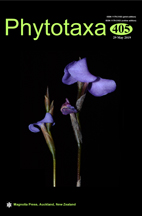Abstract
Isotrema plagiostomum X. X. Zhou & R. J. Wang, a new species of Isotrema (Aristolochiaceae) from Guangdong, south China, is described and illustrated for the first time. It is similar to I. thwaitesii in the morphology of the obliquely truncated calyx limb, but differs by the habit, leaf shape, inflorescence position and splitting extent of calyx limb. It is evaluated as CR according to the IUCN categories and criteria.

